Aditi Roy Ghatak and Paranjoy Guha Thakurta
With the MCX Stock Exchange (MCX-SX) receiving approvals in August to start trading in currency options from both the watchdog of India's capital markets, the Securities and Exchange Board of India (Sebi) and the country's banking regulator, the Reserve Bank of India (RBI), the dust may have settled on the newest stock exchange after four years of courtroom battles but fundamental questions about the state of bourse management in India remains.
As news broke in July that the MCX (Multi-Commodity Exchange)-SX would be allowed to operate as a full-fledged stock exchange - and probably be up and running by Diwali (November 13) - hopes have been raised that India's markets for not just equity shares but other financial instruments as well will now become more vibrant, competitive and inclusive.
The latest set of approvals given to MCX-SX will pave the way for the new exchange to enhance its offerings in the currency derivatives segment by introducing currency options in the US dollar-Indian rupee (USD-INR) currency pair. With the spectrum of hedging instruments available on the MCX-SX currency segment now complete, the risk mitigation mechanism in the USD-INR currency pair would get strengthened.
There are, however, several questions that require answers. Despite the presence of over 20 stock exchanges in India (prior to the advent of MCX-SX), the Bombay Stock Exchange (BSE) and the National Stock Exchange (NSE) have been and remain the only two exchanges for financial instruments that seem to matter.
Worse, for all the hullabaloo about securing a broader investor base through incentivization and a lot of exhortation even from the prime minister, not too many new people are entering the market.
Ask even informed stock market players and the verdict is that only those who know the innards of market operations - some prefer to call it manipulations - dare to venture in. As it is, the economy does not inspire confidence; financial governance of virtually every aspect of the economy stands exposed as having been vitiated; policy paralysis is the current buzz word.
Click on NEXT for more...
Will the advent of a 3rd exchange help India's bourses?
Photographs: Arko Dutta/Reuters
There are many reasons why retail investors are shunning the stock market, the principal one being that the government has hobbled the economy with rampant corruption and poor policies. There is another reason, which the Moneylife website has been highlighting frequently: rampant price manipulation and poor grievance redress system that inflicts losses on investors which also shatters their confidence in the fairness of the system.
Consider a small company that has been scanned by the Moneylife report (Stock Manipulation; Debashish Basu with Aditya Govindraj and Jason Monteiro; August 23, 2012): Out of City Travel Solutions was Tilak Finance, which was suspended for non-compliance with listing norms though the suspension was revoked. Between July 2010 and January 2012, its share price zoomed by 2,268 per cent, from Rs 2.20 to Rs 52.10.
There was nothing remarkable about performance. The reported net sales were Rs 2.3 crore (Rs 23 million) (March 2011), Rs 8.6 crore (Rs 86 million) (June 2011), Rs 3.51 crore (Rs 35 million) (September 2011) and just Rs 100,000(December 2011). The corresponding profits were: Rs 100,000 (March 2011), zero (June 2011), Rs 400,000(September 2011) and a loss of Rs 22 lakh (Rs 2.2 million) in the December 2011 quarter.
How come this curious operation does not invite scrutiny or complaint? Or does it all happen only to be swept under the carpet after a brown envelope changes hands?
The Moneylife report goes on to unveil the several layers of cross holdings in this inconspicuous company that has nothing to do with travel and one of whose directors, Girraj Kishor Agrawal, has an interesting labyrinth of companies.
While one cannot quite fathom what the objectives are but one of them is certainly to hide the director's identity and help him insider trade.
If a journalistic investigation can expose all this, why does the Sebi not make an example of such operators with exemplary action. All that one knows of is a small fine and slap on the wrist for this company.
Click on NEXT for more...
Will the advent of a 3rd exchange help India's bourses?
Photographs: Punit Paranjpe/Reuters
Will the entry of a new player make a dent in these circumstances that totally ruin the credibility of Indian bourse management. Will it end the cozy duopoly that exists for all practical purposes? Will the new exchange usher in an era of inclusion that benefits both small investors as well as small firms? Also, there is no logical explanation to why the markets suddenly started looking up with late August numbers showing a near 10 per cent rise in the Sensitive Index (Sensex) of the Bombay Stock Exchange over the past two months and, reportedly ("Why have the markets rallied while the economy flounders?" Mint, August 24, 2012), foreign institutional investors pumping in $ 3 billion in the past two months and $11.5 billion since January this year. None of the explanations pass muster.
Not surprisingly, the lay investor, who wishes to make informed decisions, is not impressed. Cynics suggest that little or nothing will change unless shareholder activism comes of age in India and activism should not remain limited to their particular stocks but to the overall operations of the system. On a broader perspective, is the need for those who manage bourses to make the exchanges far more user-friendly for small and medium sized companies.
"Despite the presence of a few activist analysts and shareholders, there is very little evidence of ordinary shareholders of companies in India standing up and fighting for their rights," says the head of a major financial services firm, who declined to be identified."The neglect of the ordinary investor explains the poor depth of the bourses in terms of small investor participation with a very meagre percentage of the country's population - less than two per cent - investing in stocks and shares," he argues.
Click on NEXT for more...
Will the advent of a 3rd exchange help India's bourses?
Photographs: Courtesy, zadeus/Wikimedia Commons
A number of studies, including one done by the National Council of Applied Economic Research in 2010, indicate that less than 10 per cent of the country's total cash savings by households is not kept at home under pillows or in cupboards and safe boxes and, instead, parked in banks or in savings accounts in post offices. Put differently, not even a tenth of India's total household savings is invested in financial instruments like stocks and shares.
A report of a working group set up by the RBI published in April indicated that savings in shares and debentures by households in India, after going up from 3.9 per cent of total savings during the decade of the 1980s to seven per cent in the following decade, came crashing down to 4.1 per cent in the first decade of the new millennium.
Why are ordinary citizens reluctant to invest their hard-earned savings in stock exchanges? An important reason is the poor state of protection practices for small investors who are often left high and dry by unscrupulous brokers acting in collusion with promoters of companies. When complaints are made, government agencies act in a sluggish if not helpless, manner.
Take the infamous case of companies that "vanished" after undertaking initial public offerings (IPOs) of shares. Between 1992 - when the Sebi Act came into being - and 1998, the number of companies listed on various stock exchanges (mainly the NSE and the BSE) doubled from around 5,000 to around 10,000. This number has halved since then.
Click on NEXT for more...
Will the advent of a 3rd exchange help India's bourses?
Photographs: Jayanta Shaw/Reuters
Investor rights activist Virendra Jain recalls how it was only after an NGO that he founded, Midas Touch Investors' Association, moved a public interest litigation petition in March 1998 in the Allahabad high court that the Ministry of Corporate Affairs (MCA) and Sebi set up a coordination committee which identified 229 companies that had "vanished".
Jain said that his organization provided the committee the names of an additional 750-odd companies that had "vanished", of which around 600 had been listed on the BSE. Letters sent to the registered offices of these companies had returned unopened. "It is truly amazing that after all these years, the MCA and Sebi are still trying to ascertain whether these companies have vanished or not on the basis of criteria that the government itself has formulated", he added.
It is not just the small investor who has run away from the country's stock exchanges. Relatively small or medium-sized companies are also not well served by the existing bourses at present. In fact, non-inclusiveness (in terms of both engaging with small investors and small companies) seems to be the pervading philosophy of the capital markets in the country.
The clout of brokers in exchanges - who often act in close concert with promoters and directors of listed companies - ensures that several instances of market manipulation that leave minority shareholders in the lurch go unreported, thereby allowing the offenders to get away without any penalties being imposed on them.Click on NEXT for more...
Will the advent of a 3rd exchange help India's bourses?
Photographs: Ajay Verma/Reuters
Will the advent of a third all-India exchange deepen India's bourses? One can merely hope that in taking on its competitors, the NSE and the BSE, the MCX-SX management will not just talk about the need for "inclusiveness" but ensure that it is brought about. To get to know this exchange:
MCX-SX is controlled by the Multi Commodity Exchange of India - India's biggest commodity bourse, which made headlines in February when it raised $135 million through an IPO in fairly depressed market conditions - together with Financial Technologies India Limited that provides software for trading terminals.
Sebi had withheld permission to the company to commence operations because it believed that the MCX-SX was not complying with its regulations. If MCX-SX does not abide by Sebi rules, its license will expire on September 15.
As a precondition for granting permission to operate its exchange, Sebi has directed the current promoters of MCX-SX to sell 60 per cent of their warrants in MCX-SX within 36 months. Both promoter companies must also cut their 10 per cent combined equity stake to five per cent.
MCX-SX has acquired a reputation of being an aggressive player in the commodities and currency futures business after it was granted recognition by the Sebi in September 2008. The exchange had, however, been permitted to do business in the currency derivatives space only.
Indeed, even though the MCX-SX started in 2008 with trading in currency futures, a few months after the NSE, it has a market share of 45 per cent at present against the NSE's 53 per cent - the extra lead that the NSE enjoys is due to its business in currency options which builds volumes in currency futures. The United Stock Exchange (USE) is the other player in the currency derivatives space.Click on NEXT for more...
Will the advent of a 3rd exchange help India's bourses?
Photographs: Akhtar Soomro/Reuters
The question that is asked is whether the MCX-SX will be able to dent the virtual duopoly of the NSE and the BSE. Since 1991, when the Indian economy started getting liberalised, the number of stock exchanges in the country fell from 24 to only two that mattered, the NSE and the BSE, with the former dominating proceedings of late. What do these two exchanges represent?
The NSE is mutually owned by a clutch of leading financial institutions, banks, insurance companies and other financial intermediaries, including at least two foreign investors, NYSE Euronext and Goldman Sachs. In 2011, NSE was the third largest stock exchange in the world in terms of the number of contracts (1,221 million) traded in equity derivatives; the sixteenth largest by way of market capitalization and the second fastest growing stock exchange in the world with a recorded growth of 16.6 per cent.
The NSE is, of course, the largest exchange in India in terms of daily turnover and number of trades, for both equities and derivatives, with a market capitalization of around billion and over 1,646 listings as on December 2011.
The Bombay Stock Exchange (BSE) is the oldest stock exchange in Asia and the equity market capitalization of the companies listed on it was roughly $1 trillion as of December 2011, making it the sixth largest stock exchange in Asia and the fourteenth largest in the world. Indeed, the BSE has the largest number of listed companies among any exchange in the world. As of March 2012, there were more than 5,133 listed Indian companies.
While both the BSE and the NSE have total market capitalisation that is similar (about $1 trillion), share volume in the NSE is typically twice that of the BSE and this has happened over a remarkably short period, thanks largely to the NSE aggressively foraying into the derivatives space.
While the NSE saw $35.9 billion in shares traded in its exchange in June as opposed to just $7.9 billion at the BSE (as per data issued by the World Federation of Exchanges) these numbers are woefully behind those obtaining in China. The Shanghai Stock Exchange recorded $190.9 trillion worth of trades in June 2012.
Click on NEXT for more...
Will the advent of a 3rd exchange help India's bourses?
Photographs: Akhtar Soomro/Reuters
In August, a Sebi report comparing 14 stock exchanges in emerging economies on the basis of market capitalization, placed BSE in the fourth position with a market capitalization of $ 1,102 billion while NSE stood in the fifth position with a market cap of $ 1,079 million - the top two exchanges were Chinese in Shanghai ($ 2,411 billion) and Shenzen ($ 1,149 billion).
The penetration of capital markets in India is pathetically low with only 1.7 per cent of the country's population having depository accounts against 15 per cent in China.
What is worse, the already-thin capital markets in this country are dominated by a few. As much as half the turnover of all stock exchanges in India is accounted for by only 25 broking firms. Ninety per cent of the turnover of all stock exchanges in the country is out of only five cities. These are hardly healthy signs of India's financial markets.
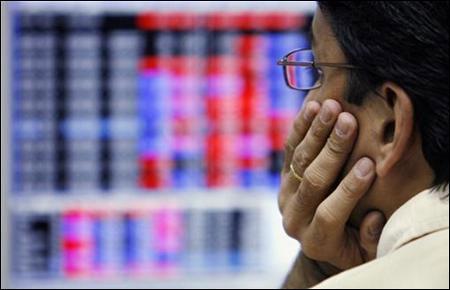
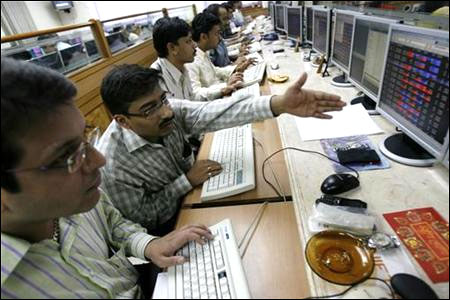
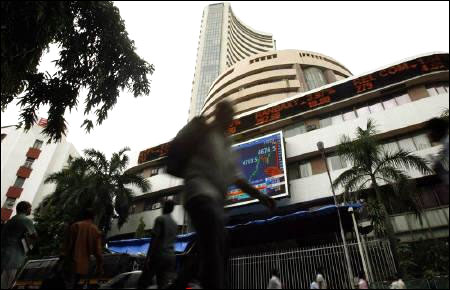

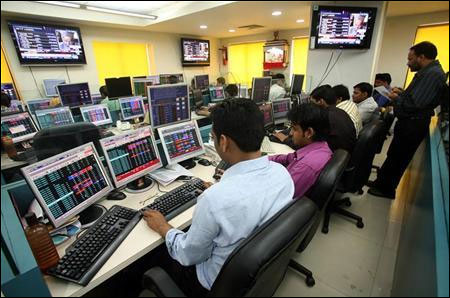

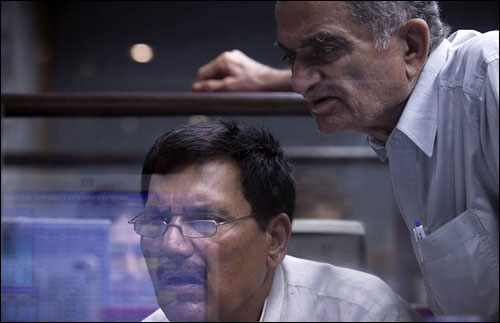
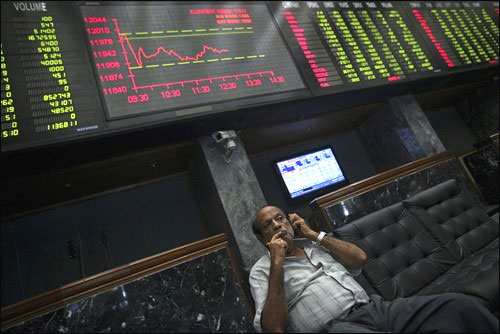
article